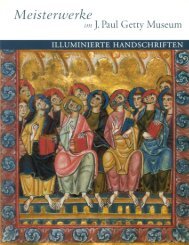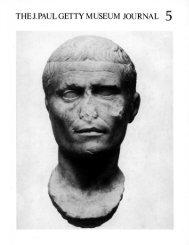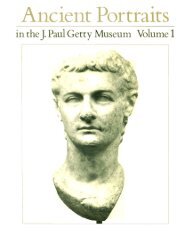The J. Paul Getty Museum Journal Volume 15 1987
The J. Paul Getty Museum Journal Volume 15 1987
The J. Paul Getty Museum Journal Volume 15 1987
You also want an ePaper? Increase the reach of your titles
YUMPU automatically turns print PDFs into web optimized ePapers that Google loves.
12 SpierFigure 8. Pendant. Found in Pantalica, Sicily, circa sixthcentury. Gold. H: 2.6 cm (1"). Present locationunknown. Drawing by Martha Breen Bredemeyerafter P. Orsi, Sicilia bizantina (Rome,1942), vol. 1, no. 7, p. 138, pi. 9.Figure 9. Engraved disc, perhaps from a pendant. Supposedlyfound in Constantinople, circa sixthcentury. Gold. H: 2.1 cm ( 7 /s"). Washington,D.C., Dumbarton Oaks Research Library andCollection 53.12.51. Photo: Courtesy DumbartonOaks Research Library and Collection,Washington, D.C.and seventh-century Byzantine goldwork suggest aslightly earlier date for the reliquary than that proposedby Ross, perhaps in the fifth century, although no closeparallels are known.<strong>The</strong> well-known gold reliquary box found in the oldbasilica at Pola (present-day Pula, Yugoslavia) and nowin Vienna 16forms a link between the Dumbarton Oaksreliquary and the group of pendants (figs. 11a—c). Its lidappears to have been inspired by the design of theDumbarton Oaks reliquary, but this has become highlystylized. <strong>The</strong> repousse cross within a wreath is replacedby a cross with glass paste inlay surrounded by a wreathof plaited gold wire. Four pyramidal clusters of goldbeads appear in the corners instead of the four acanthusleaves. <strong>The</strong> short sides have crosses bordered with cablesas in the Dumbarton Oaks example, but here, unlikethe Saint Zacharias reliquary, the stylized acanthusleaves fill the areas between the arms of the cross in themanner of the pendants.Perhaps from the same workshop is a gold cross inDumbarton Oaks, which shares with the Vienna reliquarybox the addition of plaited gold wire, clusters ofgold beads, and central glass paste inlay on one side.In a variation of the pendants' motif, the other side ofthe cross has engraved acanthus leaves in each arm(fig. 12). 17Other similar crosses are noted by Ross,as are rings decorated with similar plaited wire, includingan example in Oxford set with a coin of Zeno(A.D. 474-491). 18<strong>The</strong> similarities in the decoration of the DumbartonOaks cross, the Vienna reliquary box, and the group ofpendants indicate that all are products of the same koinestyle. A Byzantine koine style of jewelry, attested by alarge number of finds from all parts of the ByzantineEmpire, developed by the early sixth century, flourishedin the reign of Justinian, and continued well into theseventh century. <strong>The</strong>re can be little doubt that much ofthe material was manufactured in Constantinople andthat workshops located elsewhere, whether in the eastor the west, closely followed the fashions set in thecapital. <strong>The</strong> style encompasses a large body of material(including personal jewelry, such as belt buckles, earrings,finger rings, necklaces, and pendants, as well ascrosses and reliquaries), and the sharing of decorative16. H. Buschhausen, Die spaetroemischen Metallscrinia undfruehchristlichen Reliquiare (Vienna, 1971), no. B 20, pp. 249-252, pi.57, and K. Weitzmann, ed., <strong>The</strong> Age of Spirituality (New York, 1979),no. 568, pp. 630-631.17. Ross, D.O. Cat., vol. 2, no. 10, p. <strong>15</strong>.18. Ibid., no. 10, p. <strong>15</strong>; E. T. Leeds, Antiquaries <strong>Journal</strong> 20 (1944), no.4, p. 334, pi. 51.19. Other gold objects that display similarities in manufacture anddecorative detail can also be identified. For example, a small goldcross (H: 2.83 cm [lW]) engraved with the same pattern as the largerexample at Dumbarton Oaks (fig. 12) is now in a Swiss private collection;it is unpublished. Another similar example was on the Londonmarket a few years ago and was exhibited by Jack Ogden Ltd. (In theWake of Alexander, November 17—December 1, 1982, no. 27). <strong>The</strong> useof punched-dot borders is seen, for example, on an openwork ringfrom Smyrna (British <strong>Museum</strong> M&LA AF 308; Dalton, Early Chris-








